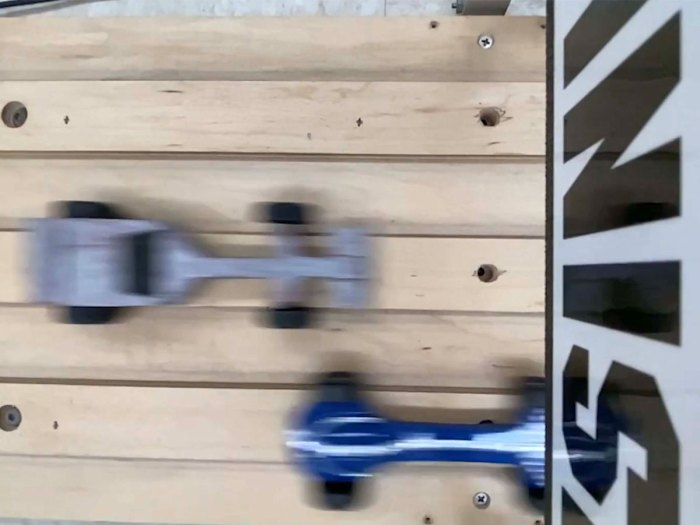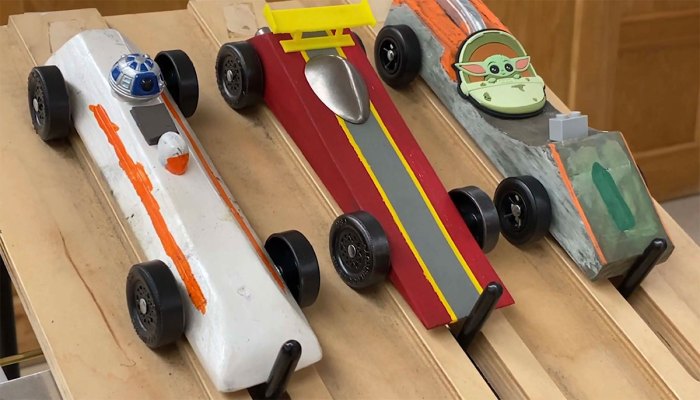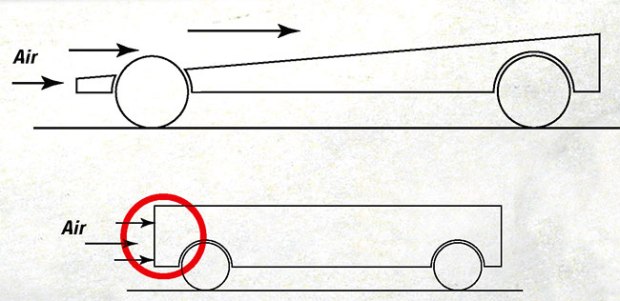How to Make a Fast Pinewood Derby Car

Packs nationwide are gearing up for their annual Pinewood Derby race, and the one thing everyone wants to know: How do I make a fast Pinewood Derby car?
There are a variety of ways to make your Pinewood Derby car go faster. Explore the following tips to optimize your car’s performance and gain a competitive edge in an upcoming race.
BASIC BUILDING GUIDELINES TO GET YOU STARTED
The possibilities are endless when it comes to creating a fast Pinewood Derby car. Before you begin, consider the following general guidelines:
Avoid Pointed Noses: A pointed nose will make it difficult for your car to rest on the pin at the starting gate. It may also cause your Pinewood Derby car to get bumped around when the pin drops, and it can create problems for electronic timing systems at the finish line.
Weight Distribution: Leave ample wood in the rear of the Pinewood Derby car so you can place additional weight there. Concentrate the majority of the weight in the rear for optimal performance.
Maximum Weight: Aim for the maximum allowable weight allowed by your pack’s rules, typically limited to 5 ounces in most races. If your car falls short of this weight, strategically add coins or other weights to meet the requirement.
Clarity in Orientation: Clearly distinguish the front and back of your Pinewood Derby car. In many races, the race officials — not you — will actually place each car on the track. Sometimes the officials put cars on the track backward because they can’t tell which end is which.
Aerodynamic Design: Select a design that facilitates smooth airflow over and around the car body. Pinewood Derby cars with aerodynamic profiles go faster.
Need design ideas? See photo galleries of hundreds of Pinewood Derby cars.

10 STEPS FOR DESIGNING AND BUILDING A FAST PINEWOOD DERBY CAR
You don’t have to strive for the fastest Pinewood Derby car to have fun competing in your Pinewood Derby. But if you and a helpful adult are willing to put in the extra time and effort, these speed tips are for you.
1. Bake the Block: Start your Pinewood Derby car project by baking the wood block at 250 degrees for two hours. This removes moisture and lightens the block, allowing you to place more weight at the rear of the car where you actually want it.

2. Crafting the Design: Outline your Pinewood Derby car on paper, cut it out, and affix it to the wood block.
Remember, a rectangular car is not an aerodynamic design. The most basic aerodynamic design is a simple wedge. If you don’t have time to design a complex car, a wedge will work just fine.
Download a Pinewood Derby car template PDF to help you create your design.
3. Rough Cut the Design: Use a coping saw or enlist the help of a responsible adult with a power tool to cut out the rough shape of your Pinewood Derby car.
4. Shape Your Car: Smooth edges and shape your car using sandpaper. An adult can assist with a rotary tool or other shaping tools.
5. Sand and Paint Creatively: Reduce friction by smoothing the car’s surface and paint an awesome design to make it look great.
How to paint your Pinewood Derby car to give it a shiny finish.
6. Axles and Wheels Alignment: Make sure they are aligned perfectly straight. You can test the alignment of your axles by pushing your car across a smooth floor or table. It should roll smoothly in a straight line.
- Consider a Three-Wheeler: Raise one wheel about 1/16 inch higher so it never actually touches the track. Less friction = more speed. Rules vary from pack to pack, so make sure to check your pack’s Pinewood Derby rules to make sure three wheelers are allowed in your race.
- Extend the Wheelbase: Maximize the distance between front and rear wheels. Again, make sure this is allowed in your race.
Inspect axles closely to make sure they are smooth without ridges or burrs. You can use sandpaper to remove any imperfections.
Learn about polishing Pinewood Derby axles and wheels to reduce friction.
7. Secure Axles with Glue: Glue the axles firmly in their holes to ensure that they stay perfectly placed, but make sure you don’t get glue on your wheels.
8. Strategic Weight Addition: Remember to make your Pinewood Derby car as heavy as the rules allow. In general, it’s best to place weight to the rear of your car because a heavier rear increases speed.
Learn scientific Pinewood Derby speed tips from a former NASA engineer.
9. Use Graphite: Add graphite or another dry lubricant to reduce friction. The less friction between the body and wheel, the better.
10. Have fun! And finally, remember the most important rule of a Pinewood Derby is that it’s supposed to be fun. While you should always strive to do your best, don’t get caught up in winning or having the fastest car. Just enjoy the ride.
Adapted from the book “Pinewood Derby Speed Secrets,” DK Publishing, $12.95 softcover.
I need to know how much graphite to put in my wheels. I have a pretty aerodynamic design, but there is a small ridge at the top. All my weight is dremeled in throughout the car or balance, and I have my weights put in, but I still need to know how much graphite to pull the ace off, I’m a webelo 2, so this is my last year. Oh my car is already weighed so that could help with how much graphite I have to put on.
dont use to mutch graghite. Last year we put graghite in at least once a day. my boys took 1st and 2nd my wife and I took 1st and 2nd in the adult class. my boys had there regionals a month later and they were puting graghite in every day some times twice a day and they were slower at regionals. Idont know if thats why.
Can you still bake it if you just did the initial cut? Not painted yet. I just forgot to bake when it was just a block !! ??
Yes you can
Be careful if you decide to bake the block. Some of the kits are not using kiln dried wood and you may end up with a warped gooey block if you try to bake the block. Weight placement, polished derby axles an alignment are much more important than shaving off the miniscule amount for weight by baking the block. My son has never baked one of his blocks and he holds our track record on a 42′ aluminum best track of 2.914 seconds. He built the car and made sure it was properly aligned. Don’t bake the block.
I’ve never heard of baking the block…
Grand Champion, my sons first year. Someone helped us cut the car, we did everything else. It was very little skill on our part because we really did not know what we were doing. Got the wheels right, the car was fast. I loved the look on my husbands face, when we brought home the trophy !
Making the yellow car on the cover of speed secrets
CAUTION!!!!
Check your local race rules. Many of the tips given in this book will be ruled illegal. Although they sell this book in the BSA store, it is misleading as to what is allowed at the District race. BEWARE.
your right!
It’s important!
I think alignment is really important its hard to get right. Use a dremel tool to lubricate your wheels. Look it up
Put any added weight as far back on the car as you can.
But not so far back that the front starts lifting off the track. (Should ensure that there is more weight in front of rear wheels than behind.)
Hope to get first from these tips!
Is 5 ounces the weight?
Yes 5 ounces
For standard rules at the regional race is 5 oz. Try not to go over that cause you don’t want to be drilling out weight if you make your car a little to heavy and are able to go to the regional race.
yes
Add several bb’s so the actual weight is 5.1oz. Then on race day break off those bb’s with pliers until the scale switches to 5.0. Then your car will weigh a fraction more than 5oz, like 5.049. Every fraction counts on these digital timed races.
which end of car is better to be front , the one farther or closer from axles, I typically put shorter in the back, was just wandering if it really made a difference?
You want the short end in the rear of your car, and the long nose in front.
Now I’ve also seen scouts, who’ve built Firetrucks, and other larger big rig vechicles
Now those type of vechicles, it is wise to go short up front and longer in the rear
short in front
I could use ALL of these tips. Last year, the best I got was 2nd place.
Second place dude that’s awesome
!
not all
dude i got 2nd place on my first try, no tips
Hey, at least 2 times we broke some of the wood. Ugliest darn car ever, sloppy paint. Well, twice we won against 14 other others in the den. Don’t lose sleep over it, just the basics and focus on the wheels and the weight. We’ve never rounded the car and we’ve beat smooth, woodshop originating vehicles.
1st… HaHa
don’t boast!
That is too cool Brother, I got 1st